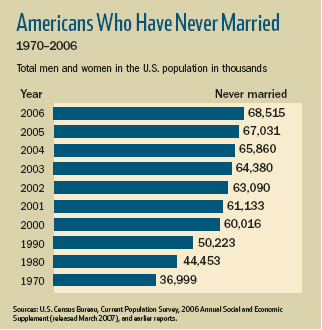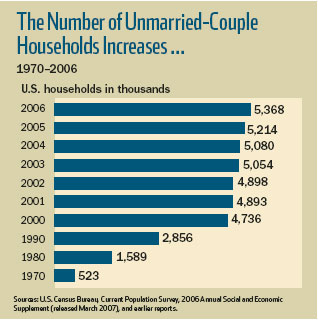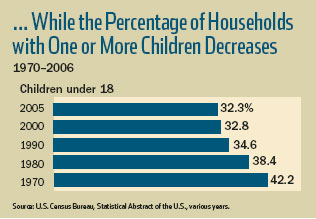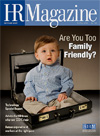As the proportion of single and childless workers increases, so do complaints of unfairness in employers’ benefits and policies.
Single employees’ inner resentment about married peers’ family needs can surface innocently enough.
Thomas Harpointner, chief executive officer of AIS Media Inc., recalls the time an employee of his Atlanta-based technology company left work early on Halloween to go trick-or-treating with his children.
"It did raise a few eyebrows," he says, "and some people poked fun about it." Half of AIS Media’s employees are unmarried.
Harpointner got the message.
"We realized that this was no joke—it was a real issue," he says. "If someone needs an afternoon off, it shouldn’t matter what the reason is. And if one employee gets the privilege, then everyone should—and we should make it a policy," he concluded.
Harpointner did just that, along with attractive enhancements to a set of employee-friendly—not solely family-friendly—benefits that apply to everyone equally and strive to reward everyone fairly by matching employees’ individual priorities, "regardless of their lives or career stages, personal situations, whatever," he says.
More employers, and their HR leaders, would be wise to do the same. According to the latest available U.S. Census Bureau data, the nation grows more unmarried with each passing year.
The Shifting Majority
Unmarried and single U.S. residents numbered 92 million in 2006, making up 42 percent of all people 18 and older. That’s up from 89 million, or 41 percent, in 2005. Sixty percent of the unmarried and single adult men and women in 2006 had never been married, up from 50 percent in 1970. Another 25 percent were divorced, and 15 percent were widowed.
Slightly more than one in four households, 26 percent, consisted of a person living alone in 2006, up from 17 percent in 1970. And of the nation’s 114 million households in 2006, 47.3 percent were headed by unmarried individuals. That figure fluctuates around 50 percent; it hit 50.3 percent in 2005, for instance.
Essentially, more people live together, marry at older ages or not at all, and rear children in cohabiting or solo-parent households, says David Popenoe, professor of sociology emeritus at the New Brunswick, N.J., campus of Rutgers University. Popenoe is founder and co-director of the National Marriage Project, a nonpartisan research organization at the school.
His July 2007 report, The Future of Marriage in America, tracks a decline of nearly 50 percent in the annual number of marriages per 1,000 unmarried adult women from 1970 to 2005. It also notes the rise in households without minor children. In 1960, for example, nearly half of all households had children under 18. By 2000, the portion had fallen to less than a third. In a few more years, it’s projected to drop to a quarter, according to the report.
These trends contribute to a burgeoning movement to promote singles’ rights, with a growing number of advocacy organizations becoming more vocal about what they perceive as unfair treatment by employers, government and society.
The Backlash
Nicky Grist, executive director of the 9,200-member Alternatives to Marriage Project Inc. (AtMP), a nonprofit advocacy organization in Brooklyn, N.Y., insists that the census data should make policy-makers and corporate decision-makers question and address some longtime, commonly held beliefs.
"More of the workforce is going to be single, unmarried or childless—or some combination," she says. "Employers—especially now—need to recognize that marital status isn’t a defining characteristic of the workplace any longer. It simply isn’t a meaningful or reliable indicator of what’s really going on in employees’ lives."
The trends reignite some of the work/life backlash that first greeted employers’ widespread adoption of "family-friendly" benefits decades ago.
While 88 percent of 1,909 employees surveyed this spring by staffing and recruitment firm Adecco USA of Melville, N.Y., said they admire working parents’ ability to "do it all" when it comes to work and family, 36 percent of men and women said parents’ flexibility at work negatively affected team dynamics, and 31 percent said employee morale suffered. Working men ages 35 to 44 reported an even greater negative perception: 59 percent of them said flexibility for working mothers caused resentment among co-workers.
 Fueling the Tension
Fueling the Tension
What causes this workplace unease to boil over? Childless singles feel put upon, taken for granted and exploited—whether because of fewer benefits, less compensation, longer hours, mandatory overtime, or less flexible schedules or leaves—by married and child-rearing co-workers.
"The overall assumption tends to be that if you’re single, you have nothing better to do—or nothing that qualifies as more important than what your married co-workers have to do—and so you’re going to have to pick up what the rest of the workforce can’t or won’t," explains Bella DePaulo, Ph.D., a visiting professor of psychology at the University of California-Santa Barbara, and author of Singled Out: How Singles are Stereotyped, Stigmatized, and Ignored, and Still Live Happily Ever After (St. Martin’s Press, 2006).
On her web site, DePaulo collects experiences and complaints from single employees regarding all kinds of perceived work and benefits inequities—and she finds they’re frustrated.
"If a single worker complains to a boss or co-worker about such things, they say they often get a hostile response," she says. "No one wants to be unfair—but when the issue’s brought out into the open, it’s obviously hitting a nerve with both parties."
Even policies dealing with office perks meant to foster employee relations can backfire. For example, DePaulo recalls an annual department picnic at a previous teaching job. Every employee was asked to pay a flat fee—no matter whether they were single or were bringing a spouse and five kids. Although the policy was unfair to singles, effectively causing them to subsidize colleagues’ families, confronting the problem without sounding insensitive was a challenge, she says.
Fostering a Singles-Friendly Environment
Wendy Casper, Ph.D., assistant professor of management in the College of Business Administration, University of Texas at Arlington, has researched single employees’ perceptions of how their organizations support their work/life balance in comparison to employees with families.
In a study of 543 singles without children published in the June 2007 issue of the Journal of Vocational Behavior, Casper and her colleagues documented that singles viewed more inequity in benefits policies and work/life support from their employers than did employees with families.
"Singles are more in tune with these perceptions than marrieds are," she says. "And company decision-makers, who may have greater access to work/life policies themselves, may not be as intuitive or sensitive to their single employees’ views."
As part of the research, Casper identified five measures of a "singles-friendly culture." Social inclusion, equal work opportunities, equal access to benefits, equal respect for nonwork life and equal work expectations are the key, defining characteristics that employers should address, assess and evaluate, the researchers suggest.
They also point to evidence that nonmonetary and more informal elements of employee relations may be as important to equalizing the varied needs of the singles workforce.
"The social inclusion factor had much greater consequences than the other issues did in terms of driving a backlash," says Casper. "Social inclusion plays a big role: When single employees have a sense of attachment and feel more supported at work, it tends to lead to greater retention, productivity and job performance."
Casper speculates that single and childless workers have stronger needs for workplace social inclusion because their relationships and overall sense of community are more likely to be connected to their jobs.
Technology company Texas Instru- ments Inc. numbers among the employers who have made an effort to increase such inclusive strategies.
To help new employees connect, for example, it started a support group in its IT Services division five years ago. The group sponsors professional development, with "lunch and learn" programs, seminars and mentoring; networking, with happy hours and other events; social events such as WhirlyBall, movies and bowling; and community services such as volunteering and charitable outreach.
Since then, there has been interest among Texas Instruments’ other business groups in forming "New Employee Initiative" groups. "It can mean a lot to have a peer group within the company," says Betty Purkey, manager of work/life strategies at the Dallas-based company.
 Creating a Wider View
Creating a Wider View
To encourage a sense of equality among all demographic groups, more company officials take a wider view of the benefits and work/life programs they provide—with an eye toward diversity, flexibility, neutrality and choice.
"The buzzword shouldn’t be ‘family-friendly,’ " says social psychologist DePaulo. "It should be ‘employee-friendly’ or ‘life-friendly.’ "
Indeed, many employers already have renamed their benefits "work/life" or "personal benefits" or have simply gotten rid of the distinction, she notes.
Some employers move to types of benefits that level the playing field by offering something for everyone.
For instance, 70 percent of 326 HR executives surveyed in 2006 by CCH and Harris Interactive said their organizations offer paid-time-off programs bundling vacation, sick and personal leave into one bank of time off that employees can manage more flexibly. In addition, 37 percent of 590 HR professionals polled for the Society for Human Resource Management’s 2007 Benefits Survey said their companies offer flexible or cafeteria-benefits plans allowing employees to choose from a variety of benefits and designate a set amount of money to pay for the benefits. These types of plans can allow for different lifestyles without rewarding employees having larger families with more benefits for the same job, for example.
Yet unequal access to employer-sponsored health insurance remains one of the top complaints of many unmarried workers with partners, including AtMP members, says Grist.
According to research by the Human Rights Coalition (HRC), a Washington, D.C., civil rights organization, a majority of Fortune 500 companies provided benefits to same-sex domestic partners in 2006. Since then, 17 more companies have added the benefits, bringing the total to 267—or 53 percent of Fortune 500 companies, the HRC says.
But while same-sex benefits have been more widely adopted among large organizations, opposite-sex domestic-partner coverage generally has seen slower adoption. In fact, all unmarried couples are still significantly less likely to have health insurance than married people, according to a 2006 study by The Williams Institute on Sexual Orientation Law and Public Policy at the University of California-Los Angeles Law School.
"We found that 20 percent of people in same-sex couples are uninsured, compared with only 10 percent of married people or 15 percent of the overall population," says M.V. Lee Badgett, the institute’s research director and co-author of the study. "Unmarried heterosexuals with partners are even worse off, with almost one-third uninsured."
This results in a continuing health-benefits gap for unmarried employees who may be in committed relationships or have other family members they’d like to cover but can’t, says Grist. "Access to domestic-partner coverage depends on the definition of your relationship—and whether it’s legally recognized," she says. "There’s not a clear, legal status that currently describes a lot of these interdependent relationships." Only a few states currently recognize unmarried relationships.
Wayne Wright, Ph.D., and his partner of eight years, Madeline Holler, fell into that gap two years ago after relocating to Southern California from St. Louis. He had accepted a job as an assistant professor of philosophy at a state university. It was his understanding, he says, that his new job’s benefits package included coverage for domestic partners—a perk that he and Holler had enjoyed at his previous employer.
Shortly after their move, however, "our ‘unmarriage’ began to unravel," Holler says.
It wasn’t until orientation for new faculty members, Wright says, that he learned that his employer’s domestic-partner coverage applied only to same-sex couples—a distinction that wasn’t initially described. And with the first $400 health insurance premium coming due to continue coverage under COBRA for Holler, Wright felt they had no choice, he says. He booked a hotel room in Las Vegas for the following weekend, and he and Holler were married at the celebrated drive-through on the Strip called The Little White Wedding Chapel.
While they hold no grudges and are secure in their relationship, Wright and Holler also say they felt powerless over what should be a personal life decision. "We absolutely felt forced to do it," Wright says.
 Ending Special Deals and Stigma
Ending Special Deals and Stigma
While companies continue to diversify their benefits, some employers strive to custom tailor the entire employment relationship—including responsibilities, scheduling, workload and benefits—in an effort to end perceived tensions between employee groups and to improve recruitment and retention.
"In the past, an employee who wanted to work in a different way might have made a personal deal with his or her boss," says Ellen Galinsky, president and co-founder of the Families and Work Institute in New York. "Today, employees and employers are working together to find new ways to restructure the workplace in unique ways to give people the flexibility they need and to improve bottom-line business measures like productivity and retention."
Take ARUP Laboratories in Salt Lake City, where employees suggested the unusual idea of a seven-days-on, seven-days-off scheme. Workdays are 10 hours each, so employees log 70 hours in all during any given two-week period. They’re paid, however, for two 40-hour weeks.
This flexible scheduling, and other forms of flexibility, help the medical-testing company recruit employees in the face of a national health care talent shortage.
Each worker is paired with a counterpart handling the opposite schedule; the two cover for each other if they have conflicts.
"We’ve created a self-functioning, stable team in which employees essentially get 26 free weeks a year to do with what they choose or need—take time with children, take a class, do volunteer work or go skiing," says Von Madsen, assistant vice president, human resources manager. Along with its menu of equal and neutral employee benefits, the flexible-schedule policy has helped the 2,100-employee company reduce turnover from an industry average of 22 percent to about 14 percent, Madsen says.
The flexibility also has had a positive effect on perceived scheduling and time-off inequities among singles and families.
"It helped eliminate the rift between employees with children and those without, who sometimes felt they had to cover the workload for parents who took additional time off for their children’s needs," Madsen says. "It’s created a more even footing."
At accounting giant Deloitte & Touche USA LLP, a new approach to career planning will become a corporate mandate in the next year.
Called "mass career customization," the initiative encourages every employee to engage in upfront, open discussion and custom planning about the course of his or her career and life-balance needs, according to Cathleen Benko, vice chairman and managing principal of talent, and co-author of a book about the program, Mass Career Customization: Aligning the Workforce with Today’s Nontraditional Workforce (Harvard Business School Press, September 2007).
Changing demographics played a part in the design.
"The family structure has fundamentally changed in this country—83 percent of U.S. households are now considered ‘nontraditional,’ and singles are certainly a part," Benko says. "There’s little wonder why many executives are either sensing or already confronting mounting tensions."
Benko suspects these tensions are rooted in the misalignment between the traditional workplace and the largely nontraditional workforce, explaining, "The one-size-fits-all approach no longer works."
Her model divides work into four dimensions—pace, workload, location and schedule, and role—and then builds career objectives in each dimension that match employees’ life circumstances along the way, allowing employees to "dial up and down," she says, and then revisiting these choices periodically as circumstances change.
Since 2005, the concept has been pilot tested and is now in the midst of a phased, 12-month rollout companywide, Benko says. Eventually, all 42,000 employees will be enrolled.
Interestingly, she notes, the pilots so far have found that "rather than dialing down on their careers, many employees were choosing to dial up," reflecting, in part, the fact that 65 percent of Deloitte’s employees are under the age of 35. "Dialing up" refers to increasing one’s professional commitment, perhaps by returning to full-time hours or adding hours, seeking the promotion fast-track, or going after opportunities for higher rewards and compensation.
During the pilots, Benko says, employee job satisfaction and retention also rose.
"This approach works because it takes a lattice, rather than ladder, approach to job moves," she says. "Work doesn’t have to be an ‘up or out’ route, and we have a system here that’s fluid and adaptable through all life and career stages."
Including All Perspectives
As Deloitte & Touche and other employers test employment customization, one thing is certain: Employment and work/life policies will continue to evolve, as different demographic groups force change and inclusion. And unlike the personal demographic characteristics that workers bring to their jobs, experts say that employers hold the power to create supportive workplace policies.
Demographics change in a clear direction, says DePaulo. Raising awareness and thinking in a broader perspective about the makeup of the workplace become more important. "A singles perspective should be acknowledged right along with the other perspectives. It’s not the only perspective, but it should be one of them."
Susan J. Wells, a business journalist in the Washington, D.C., area and a contributing editor of HR Magazine, has more than 20 years of experience covering business news and workforce issues.
An organization run by AI is not a futuristic concept. Such technology is already a part of many workplaces and will continue to shape the labor market and HR. Here's how employers and employees can successfully manage generative AI and other AI-powered systems.




